佛教概况全英文介绍
佛教概况 全英文介绍
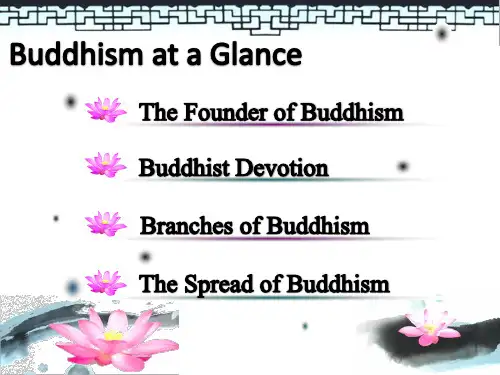
---The Buddha. (佛宝)
Those who have attained Nirvana The Buddha could also be represented as a concept instead of a specific person: the perfect wisdom that understands Dharma and sees reality in its true form.
Two Major Branches
Theravada Mahayana
(the School of the Elders) (the Great Vehicle)
对佛的看法
修行目标
世界只有一佛
追求自我解脱 最高果位:罗汉 (重在利己)
十方世界都有佛
普渡众生以成佛 罗汉—菩萨—佛 (重在利他)
Buddha
Turning the dharmacakra 转法轮
Four Main Pilgrimage Sites
Lumbini: birthplace (in Nepal)
Bodh Gaya: the place of his Enlightenment
Sarnath: where he delivered his first teachibet and Mongolia, and Vajrayana adjacent parts of China and Russia
The route?
皈 依 三 宝
Tripitaka- “Three Baskets” “ 三藏”
《经藏》 《论藏》
《律藏》
Sutras
• mainly teachings and sermons of Buddha originally transcribed in Sanskrit or Pali • descriptions of Buddha and parables which may help lead to enlightenment of the reader
介绍灵山大佛英文作文
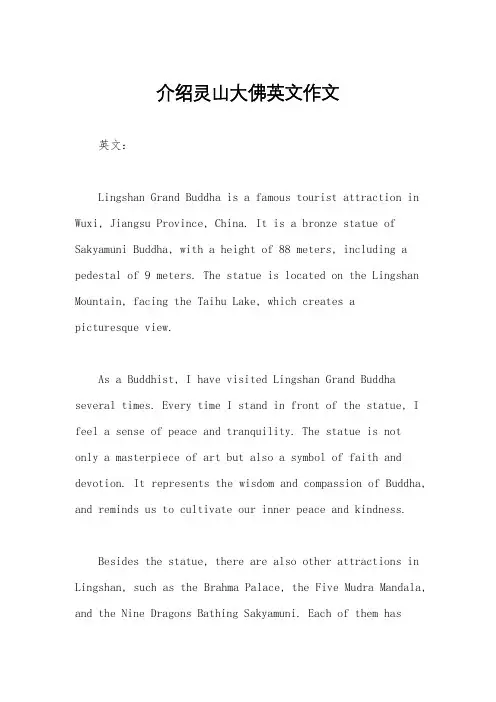
介绍灵山大佛英文作文英文:Lingshan Grand Buddha is a famous tourist attraction in Wuxi, Jiangsu Province, China. It is a bronze statue of Sakyamuni Buddha, with a height of 88 meters, including a pedestal of 9 meters. The statue is located on the Lingshan Mountain, facing the Taihu Lake, which creates apicturesque view.As a Buddhist, I have visited Lingshan Grand Buddha several times. Every time I stand in front of the statue, I feel a sense of peace and tranquility. The statue is notonly a masterpiece of art but also a symbol of faith and devotion. It represents the wisdom and compassion of Buddha, and reminds us to cultivate our inner peace and kindness.Besides the statue, there are also other attractions in Lingshan, such as the Brahma Palace, the Five Mudra Mandala, and the Nine Dragons Bathing Sakyamuni. Each of them hasits unique features and meanings. For example, the Brahma Palace is a temple dedicated to Brahma, the creator of the universe in Hinduism. It is a fusion of Chinese and Indian culture, which shows the inclusiveness and diversity of Lingshan.In conclusion, Lingshan Grand Buddha is not only a tourist attraction but also a spiritual destination. It is a place where people can admire the beauty of art and nature, and also seek for inner peace and enlightenment.中文:灵山大佛是中国江苏省无锡市著名的旅游景点。
中国佛教、墨子、韩非子英语介绍
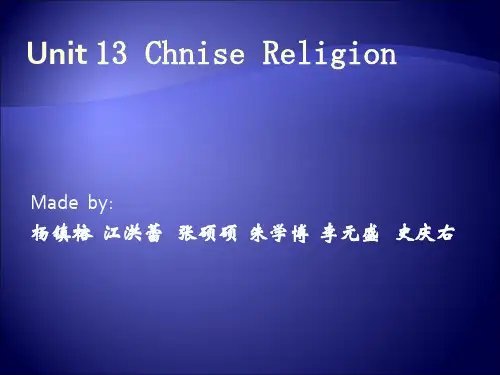
Mohism died out when the emerging imperial dynastic system promoted a Confucian orthodoxy. Daoism, similarly, grew out of a relativistic analysis of the Confucian-Mohist debate. Arguably, we owe to Mozi the fact that Chinese philosophy exists. Without him, Confucianism might never have risen above "wise man" sayings and Daoism might have languished as nothing more than a "Yellow Emperor" cult.
隋代佛林立。唐 代统治者如唐太宗、武则 天等依然笃信佛教。唐初, 玄奘西行,艰辛求法17年, 回国后共译佛经372部, 为佛教在中国的传播作出 了杰出的贡献。
玄 奘 法 师
The time of Buddhism comes into China
comparison
respect of elders by their children; respect of husbands by their wives.
universal love
comparison
Mozi believe in universal love. He uses this story to criticize Confucian pro-family and "partial" moral attitudes. He depicts a conscript leaving his family to make war. It argues that if he were concerned about his family, he would want those to whom he entrusts them to adopt an attitude of universal concern. Confucian partiality is "inconstant" in that it recommends a public daoguiding discourse that is inconsistent with it. It can not consistently recommend itself as the collective social moral.
佛教英文导游词
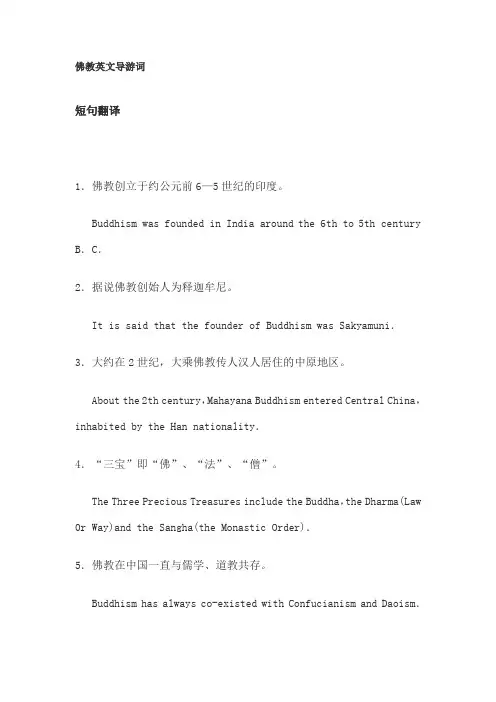
佛教英文导游词短句翻译1.佛教创立于约公元前6—5世纪的印度。
Buddhism was founded in India around the 6th to5th century B.C.2.据说佛教创始人为释迦牟尼。
It is said that the founder of Buddhism was Sakyamuni.3.大约在2世纪,大乘佛教传人汉人居住的中原地区。
About the2th century,Mahayana Buddhism entered Central China,inhabited by the Han nationality.4.“三宝”即“佛”、“法”、“僧”。
The Three Precious Treasures include the Buddha,the Dharma(Law 0r Way)and the Sangha(the Monastic Order).5.佛教在中国一直与儒学、道教共存。
Buddhism has always co-existed with Confucianism and Daoism.6.佛像和菩萨雕塑供奉在寺院里,让人们拜祭。
Buddhism has and Bodhisattva statues have been placed for worship in monasteries.长句翻译7.直到现在,小乘佛教仍然流行于傣族地区。
Up to the present time.Hinayana Buddhism(Lesser Vehicle)is still prevalent as in the regions inhabited by Dai nationality.8.传统之间相互共存促进了有中国特色的宗教的形成。
Their mutual co-existence of the tradition has produced a religion with distinct Chinese characteristics.9.同一个寺院里除释迦牟尼以外,还供奉了许多其他佛像和菩萨雕塑。
介绍中国佛教的英语作文
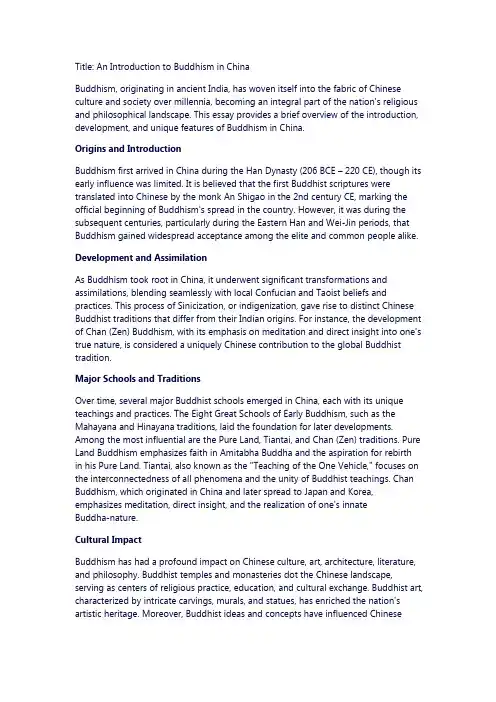
Title: An Introduction to Buddhism in ChinaBuddhism, originating in ancient India, has woven itself into the fabric of Chinese culture and society over millennia, becoming an integral part of the nation's religious and philosophical landscape. This essay provides a brief overview of the introduction, development, and unique features of Buddhism in China.Origins and IntroductionBuddhism first arrived in China during the Han Dynasty (206 BCE – 220 CE), though its early influence was limited. It is believed that the first Buddhist scriptures were translated into Chinese by the monk An Shigao in the 2nd century CE, marking the official beginning of Buddhism's spread in the country. However, it was during the subsequent centuries, particularly during the Eastern Han and Wei-Jin periods, that Buddhism gained widespread acceptance among the elite and common people alike. Development and AssimilationAs Buddhism took root in China, it underwent significant transformations and assimilations, blending seamlessly with local Confucian and Taoist beliefs and practices. This process of Sinicization, or indigenization, gave rise to distinct Chinese Buddhist traditions that differ from their Indian origins. For instance, the development of Chan (Zen) Buddhism, with its emphasis on meditation and direct insight into one's true nature, is considered a uniquely Chinese contribution to the global Buddhist tradition.Major Schools and TraditionsOver time, several major Buddhist schools emerged in China, each with its unique teachings and practices. The Eight Great Schools of Early Buddhism, such as the Mahayana and Hinayana traditions, laid the foundation for later developments. Among the most influential are the Pure Land, Tiantai, and Chan (Zen) traditions. Pure Land Buddhism emphasizes faith in Amitabha Buddha and the aspiration for rebirth in his Pure Land. Tiantai, also known as the "Teaching of the One Vehicle," focuses on the interconnectedness of all phenomena and the unity of Buddhist teachings. Chan Buddhism, which originated in China and later spread to Japan and Korea, emphasizes meditation, direct insight, and the realization of one's innateBuddha-nature.Cultural ImpactBuddhism has had a profound impact on Chinese culture, art, architecture, literature, and philosophy. Buddhist temples and monasteries dot the Chinese landscape, serving as centers of religious practice, education, and cultural exchange. Buddhist art, characterized by intricate carvings, murals, and statues, has enriched the nation's artistic heritage. Moreover, Buddhist ideas and concepts have influenced Chineseliterature, particularly in the form of poetry and prose, where themes of enlightenment, impermanence, and compassion are frequently explored. ConclusionBuddhism in China is a testament to the resilience and adaptability of religious traditions as they traverse geographical and cultural boundaries. Through centuries of assimilation and innovation, Buddhism has become an inseparable part of Chinese identity, shaping the nation's spiritual landscape and contributing to its rich cultural heritage. Today, Buddhism continues to inspire millions of people in China and around the world, offering a path to enlightenment, peace, and harmony.。
Buddhis佛教
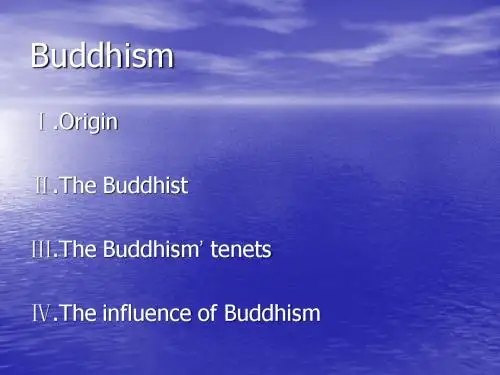
ⅡThe Buddhist
• 1. Mahayana • One of the major schools of Buddhism, active in Japan, Korea,
Nepal, Tibet, Mongolia, and China, which teaches social concern and universal salvation. • 大乘佛教:佛教的主要流派之一,流传于日本、朝鲜、尼泊尔、西藏、 蒙古和中国,教导人们关心社会和普渡众生
8.Right meditation
complete concentration on a single object and the achievement of purity of thought,free from all hindrances and distractions.
㈢The Karma
• Karma is concerned with action–reaction action–
and with cause and effect:good deeds bring results;corrupt deeds bring corrupt results. • The continuing cycle of suffering and rebirth.
Mogao Caves
• 敦煌莫高窟
• 麦积山石窟Maiji Mountain Grottoes 麦积山石窟Maiji
• 龙门石窟Longmen Grottoes 龙门石窟Longmen
• 玄奘西行路线图
The devotion of Xuanzang
• 据载,玄奘前后共译经论75部,总计1335卷。所译之 据载,玄奘前后共译经论 部 总计1335卷 共译经论75
常见佛教英语
常见佛教英语佛教Buddhism三大语系佛教Three languages of Buddhism:汉语系佛教Chinese Language Buddhism藏语系佛教Tibetan Language Buddhism巴利语系佛教Pali Language Buddhism大乘佛教Mahayana Buddhism上座部佛教Theravada Buddhism金刚乘/密宗Vajrayana Buddhism(Lamaism)中国佛教Chinese Buddhism佛经Sutra经、律、论Sutras, Vinaya, Sastra大藏经Tripitaka Sutra三宝(佛、法、僧)Triratna (Buddha, Dharma,Sangha)“三宝”加被May “Triratna”bless法师Master/Venerable长老Thero/Venerable大长老Mahathero/ Most V enerable方丈/主持Abbot佛教宗派Buddhist School佛教仪式:Buddhist Ceremony/Buddhist Service for和平祈祷法会Buddhist Praying Ceremony for World Peace礼佛pay respect for Buddha颂经Sutra Chanting香炉Incense burner上香To offer incense to Buddha因果Cause and effect成道/成佛To obtain the Buddha-hood觉悟To get enlightenment三皈五戒The ceremony for lay Buddhists to go to the Buddha for refuge, go to the Dharma for refuge, go to the Sangha for refuge and to follow the five commandments of Buddhism(no killing,no stealing,no sexual misconduct,no lying,no intoxicant)诸恶莫做,众善奉行,自净其意,既是佛教“To do no evil, to do only good, to purify the will, is thedoctrine of all Buddhas”做功德To make contribution to普渡终生To save all living beings from sufferings四谛Four noble truths八正道Eight noble paths善哉Sadhu (good or excellent)佛教寺院Monastery/Buddhist Temple山门The Front Gate大雄宝殿The Main Shrine Hall圆通殿The Hall of Universal Understanding观音殿The Hall of Avalokitesvara Buddhisatva藏经阁The Tripitaka Sutra Pavilion罗汉堂The Hall of Arhan祖师殿The Hall of Patriarch四大天王Four deva-kings, the protectors of Buddhism韦驮Vitasoka/Vigatasoka, the protector of Buddhism斋堂Monastic Dinning Hall客堂Monastic Reception四大名山:Four holy mountains of Chinese Buddhism五台山Wutai Mountain is the Holy Place of Manjusri Buddhisattva峨嵋山Ermei Mountain is the Holy Place of Mahasthama Buddhisattva 九华山Jiuhua Mountain is the holy place of Ksitigarbha Buddhisattva 普陀山Putuo Mountain is the holy place of Avalokitesvara Buddhisattva 佛像Buddha statue释迦牟尼佛Shakyamuni Buddha弥勒佛Maitreya Buddha迦叶佛Kasyapa Buddha阿弥陀佛Amitaba Buddha毗庐舍那佛Vairocana Buddha药师佛Bhaisajya Buddha/medicine Buddha三世佛Buddhas of Three Periods:Kasyapa Buddha of the pastShakyamuni Buddha of the present,Maitrya Buddha of the future菩萨Buddhisattva观世音菩萨Avalokitesvara Buddhisattva菩贤菩萨Samandhabatra Buddhisattva大势智菩萨Mahasthamaprapta Buddhisattva文殊菩萨Manjusri Buddisattva地藏菩萨ksitigahba Buddhisattva善财童子Sudhana罗汉Arhan西方三圣:阿弥陀佛、观音菩萨、大势至菩萨Amitaba BuddhaAvalokitesvara BuddhisattvaMahasthamaprapta Buddhisattva达摩Budhidharma摩腾Kasyapa Matanga竺法兰Gobharana/Dharmaraksa佛学院Buddhist College僧伽Sangha僧、尼(比丘、比丘尼)monk、nun /Bhiksu, Bhiksuni方丈/主持Abbot首座Chief monk监院/当家Monastic Manger侍者Assistant中国佛教协会The Buddhist Association of China中国佛学院The Buddhist Academy of China会长President副会长Vice President秘书长Secretary General副秘书长Deputy Secretary General佛学英语词汇the Great Vehicle d大乘the Lesser Vehicle 小乘the Diamond Vehicle 金刚乘Four Noble Truths 四圣谛苦suffering集causes of suffering灭suppression of suffering 道path to suppression of sufferingTwelve Links in the Chain of Causation 十二因缘cycle of rebirths 轮回ignorance 惑nirvana 涅磐greed 贪hatred 嗔stupidity 痴pride 慢hesitation 疑wrong view 恶见no-soul 无我impermanence 无常sentient beings 众生deva 天human 人asura 阿修罗animal 畜牲hungry ghost 饿鬼denizen of hell 地狱morality 戒concentration 定wisdom 慧action 身speech 口consciousness 意lay Buddhists 居士novice monks 沙弥monks 比丘Five Precepts 五戒personal enlightenment 自觉universal enlightenment 觉他full enlightenment 觉满Buddha of Medicine 药师佛Buddha Maitreya 弥勒佛body of essence 法身award body 报身body of transformation 化身Four Heavenly Kings 四天王karma 因果Buddha Amitaba 阿弥陀佛Buddha of Sunlight (法身佛)毗卢遮那佛Buddha Sakyamuni 释迦牟尼佛Bodhisattva of Compassion 观音菩萨Boohisattva of Ultimate Knowledge 文殊菩萨Bodhisattva of Universal Benevolence 普贤菩萨Bodhisattva of Great Power 大势至菩萨bodhi 菩提dhyana 禅那sangha 僧团saha 娑婆五蕴five aggregates色aggregate of material body受aggregate of feelings想aggregate of perceptions 行aggregate of predispositions识aggregate of consciousness简单佛学英语Birth is suffering; aging is suffering;生是苦;老是苦;sickness is suffering; death is suffering;病是苦;死是苦;association with the unpleasant is suffering;怨憎会是苦;dissociation from the pleasant is suffering;爱别离是苦;not to get what one wants is suffering;求不得是苦;in short, attachment to the five aggregates is suffering.简言之,对五蕴的执取就是苦。
五分钟介绍佛教
A Five Minute Introduction to Buddhism五分钟介绍佛教(英文与中文)•What is Buddhism? 什么是佛教?Buddhism is a religion to about 300 million people around the world. The word comes from 'budhi', 'to awaken'. It has its origins about 2,500 years ago when Siddhartha Gotama, known as the Buddha, was himself awakened (enlightened) at the age of 35.佛教是一种约有三亿人信仰的世界性宗教。
这个词来自于'菩堤',意思是'觉悟' 。
佛教大约起源于2500年前,是悉达多乔达摩(称为佛陀)在35岁时觉悟后所发起的。
•Is Buddhism a Religion? 佛教是一种宗教吗?To many, Buddhism goes beyond religion and is more of a philosophy or 'way of life'. It is a philosophy because philosophy 'means love of wisdom' and the Buddhist path can be summed up as:(1) to lead a moral life,(2) to be mindful and aware of thoughts and actions, and(3) to develop wisdom and understanding.对于许多人来说,佛教超越宗教,更象是一种哲学或'生活艺术' 。
佛教英语 (2)
常见佛教英语佛教Buddhism三大语系佛教Three languages of Buddhism: 汉语系佛教Chinese Language Buddhism藏语系佛教Tibetan Language Buddhism巴利语系佛教Pali Language Buddhism大乘佛教Mahayana Buddhism上座部佛教Theravada Buddhism金刚乘/密宗Vajrayana Buddhism(Lamaism) 中国佛教Chinese Buddhism佛经Sutra经、律、论Sutras, Vinaya, Sastra大藏经Tripitaka Sutra三宝(佛、法、僧)Triratna (Buddha, Dharma,Sangha)“三宝”加被May “Triratna”bless法师Master/Venerable长老Thero/Venerable大长老Mahathero/ Most Venerable方丈/主持Abbot佛教宗派Buddhist School佛教仪式:Buddhist Ceremony/Buddhist Service for和平祈祷法会Buddhist Praying Ceremony for World Peace礼佛pay respect for Buddha颂经Sutra Chanting香炉Incense burner上香To offer incense to Buddha因果Cause and effect成道/成佛To obtain the Buddha-hood觉悟To get enlightenment三皈五戒The ceremony for lay Buddhists to go to the Buddha for refuge, go to the Dharma for refuge, go to the Sangha for refuge and to follow the five commandments of Buddhism(no killing,no stealing,no sexual misconduct,no lying,no intoxicant)诸恶莫做,众善奉行,自净其意,既是佛教“To do no evil, to do only good, to purify the will, is thedoctrine of all Buddhas” 做功德To make contribution to普渡终生To save all living beings from sufferings四谛Four noble truths八正道Eight noble paths善哉Sadhu (good or excellent)佛教寺院Monastery/Buddhist Temple山门The Front Gate大雄宝殿The Main Shrine Hall圆通殿The Hall of Universal Understanding 观音殿The Hall of Avalokitesvara Buddhisatva 藏经阁The Tripitaka Sutra Pavilion罗汉堂The Hall of Arhan祖师殿The Hall of Patriarch四大天王Four deva-kings, the protectors of Buddhism韦驮Vitasoka/Vigatasoka, the protector of Buddhism斋堂Monastic Dinning Hall客堂Monastic Reception四大名山:Four holy mountains of Chinese Buddhism五台山Wutai Mountain is the Holy Place of Manjusri Buddhisattva峨嵋山Ermei Mountain is the Holy Place of Mahasthama Buddhisattva九华山Jiuhua Mountain is the holy place of Ksitigarbha Buddhisattva普陀山Putuo Mountain is the holy place of Avalokitesvara Buddhisattva佛像Buddha statue释迦牟尼佛Shakyamuni Buddha弥勒佛Maitreya Buddha迦叶佛Kasyapa Buddha阿弥陀佛Amitaba Buddha毗庐舍那佛Vairocana Buddha药师佛Bhaisajya Buddha/medicine Buddha三世佛Buddhas of Three Periods: Kasyapa Buddha of the pastShakyamuni Buddha of the present,Maitrya Buddha of the future菩萨Buddhisattva观世音菩萨Avalokitesvara Buddhisattva菩贤菩萨Samandhabatra Buddhisattva大势智菩萨Mahasthamaprapta Buddhisattva 文殊菩萨Manjusri Buddisattva地藏菩萨ksitigahba Buddhisattva善财童子Sudhana罗汉Arhan西方三圣:阿弥陀佛、观音菩萨、大势至菩萨Amitaba BuddhaAvalokitesvara Buddhisattva Mahasthamaprapta Buddhisattva达摩Budhidharma摩腾Kasyapa Matanga竺法兰Gobharana/Dharmaraksa佛学院Buddhist College僧伽Sangha僧、尼(比丘、比丘尼)monk、nun /Bhiksu, Bhiksuni方丈/主持Abbot首座Chief monk监院/当家Monastic Manger侍者Assistant中国佛教协会The Buddhist Association of China中国佛学院The Buddhist Academy of China 会长President副会长Vice President秘书长Secretary General副秘书长Deputy Secretary General佛学英语词汇the Great Vehicle d大乘the Lesser Vehicle 小乘the Diamond Vehicle 金刚乘Four Noble Truths 四圣谛苦suffering集causes of suffering灭suppression of suffering道path to suppression of sufferingTwelve Links in the Chain of Causation 十二因缘cycle of rebirths 轮回ignorance 惑nirvana 涅磐greed 贪hatred 嗔stupidity 痴pride 慢hesitation 疑wrong view 恶见no-soul 无我impermanence 无常sentient beings 众生deva 天human 人asura 阿修罗animal 畜牲hungry ghost 饿鬼denizen of hell 地狱morality 戒concentration 定wisdom 慧action 身speech 口consciousness 意lay Buddhists 居士novice monks 沙弥monks 比丘Five Precepts 五戒personal enlightenment 自觉universal enlightenment 觉他full enlightenment 觉满Buddha of Medicine 药师佛Buddha Maitreya 弥勒佛body of essence 法身award body 报身body of transformation 化身Four Heavenly Kings 四天王karma 因果Buddha Amitaba 阿弥陀佛Buddha of Sunlight (法身佛)毗卢遮那佛Buddha Sakyamuni 释迦牟尼佛Bodhisattva of Compassion 观音菩萨Boohisattva of Ultimate Knowledge 文殊菩萨Bodhisattva of Universal Benevolence 普贤菩萨Bodhisattva of Great Power 大势至菩萨bodhi 菩提dhyana 禅那sangha 僧团saha 娑婆五蕴five aggregates色aggregate of material body受aggregate of feelings想aggregate of perceptions行aggregate of predispositions识aggregate of consciousness简单佛学英语Birth is suffering; aging is suffering;生是苦;老是苦;sickness is suffering; death is suffering;病是苦;死是苦;association with the unpleasant is suffering;怨憎会是苦;dissociation from the pleasant is suffering;爱别离是苦;not to get what one wants is suffering;求不得是苦;in short, attachment to the five aggregates is suffering.简言之,对五蕴的执取就是苦。
用英文介绍弘法寺作文
用英文介绍弘法寺作文首段(Introduction):In the grand tapestry of China's rich cultural and religious heritage lies a gem that is Hongfa Temple (弘法寺). Nestled amidst picturesque landscapes, this Buddhist sanctuary not only serves as a spiritual hub for devout followers but also stands as an emblematic testament to the profound wisdom and history encapsulated in Chinese Buddhism.English Version:Situated within the intricate embroidery of China’s abundant cultural and religious legacy is the remarkable Hongfa Temple. Settled scenically among breathtaking landscapes, this Buddhist haven functions not merely as a spiritual epicenter for ardent devotees but also embodies a symbolic testament to the deep-rooted wisdom and historical significance embedded within Chinese Buddhism.第二段(History):弘法寺,位于中国广东省深圳市,始建于1985年,由本焕长老亲自选址并主持修建。
